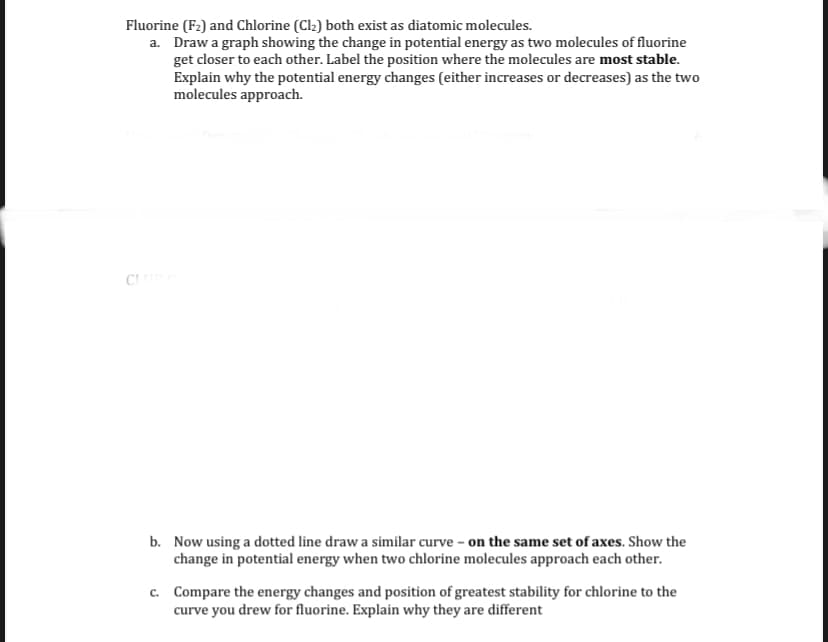Draw a graph showing the change in potential energy as two molecules of fluorine get closer to each other. Label the position where the molecules are most stable. Explain why the potential energy changes (either increases or decreases) as the two molecules approach. Now using a dotted line draw a similar curve - on the same set of axes. Show the change in potential energy when two chlorine molecules approach each other. Compare the energy changes and position of greatest stability for chlorine to the curve you drew for fluorine. Explain why they are different
Draw a graph showing the change in potential energy as two molecules of fluorine get closer to each other. Label the position where the molecules are most stable. Explain why the potential energy changes (either increases or decreases) as the two molecules approach. Now using a dotted line draw a similar curve - on the same set of axes. Show the change in potential energy when two chlorine molecules approach each other. Compare the energy changes and position of greatest stability for chlorine to the curve you drew for fluorine. Explain why they are different
Introductory Chemistry: A Foundation
9th Edition
ISBN:9781337399425
Author:Steven S. Zumdahl, Donald J. DeCoste
Publisher:Steven S. Zumdahl, Donald J. DeCoste
Chapter12: Chemical Bonding
Section: Chapter Questions
Problem 5CR
Related questions
Question
please help me answer this questions

Transcribed Image Text:Fluorine (F2) and Chlorine (Cl2) both exist as diatomic molecules.
a. Draw a graph showing the change in potential energy as two molecules of fluorine
get closer to each other. Label the position where the molecules are most stable.
Explain why the potential energy changes (either increases or decreases) as the two
molecules approach.
C
b. Now using a dotted line draw a similar curve - on the same set of axes. Show the
change in potential energy when two chlorine molecules approach each other.
c. Compare the energy changes and position of greatest stability for chlorine to the
curve you drew for fluorine. Explain why they are different
Expert Solution
This question has been solved!
Explore an expertly crafted, step-by-step solution for a thorough understanding of key concepts.
This is a popular solution!
Trending now
This is a popular solution!
Step by step
Solved in 2 steps with 1 images

Knowledge Booster
Learn more about
Need a deep-dive on the concept behind this application? Look no further. Learn more about this topic, chemistry and related others by exploring similar questions and additional content below.Recommended textbooks for you

Introductory Chemistry: A Foundation
Chemistry
ISBN:
9781337399425
Author:
Steven S. Zumdahl, Donald J. DeCoste
Publisher:
Cengage Learning

Chemistry & Chemical Reactivity
Chemistry
ISBN:
9781133949640
Author:
John C. Kotz, Paul M. Treichel, John Townsend, David Treichel
Publisher:
Cengage Learning

Chemistry & Chemical Reactivity
Chemistry
ISBN:
9781337399074
Author:
John C. Kotz, Paul M. Treichel, John Townsend, David Treichel
Publisher:
Cengage Learning

Introductory Chemistry: A Foundation
Chemistry
ISBN:
9781337399425
Author:
Steven S. Zumdahl, Donald J. DeCoste
Publisher:
Cengage Learning

Chemistry & Chemical Reactivity
Chemistry
ISBN:
9781133949640
Author:
John C. Kotz, Paul M. Treichel, John Townsend, David Treichel
Publisher:
Cengage Learning

Chemistry & Chemical Reactivity
Chemistry
ISBN:
9781337399074
Author:
John C. Kotz, Paul M. Treichel, John Townsend, David Treichel
Publisher:
Cengage Learning

Chemistry: The Molecular Science
Chemistry
ISBN:
9781285199047
Author:
John W. Moore, Conrad L. Stanitski
Publisher:
Cengage Learning

Chemistry for Engineering Students
Chemistry
ISBN:
9781337398909
Author:
Lawrence S. Brown, Tom Holme
Publisher:
Cengage Learning
